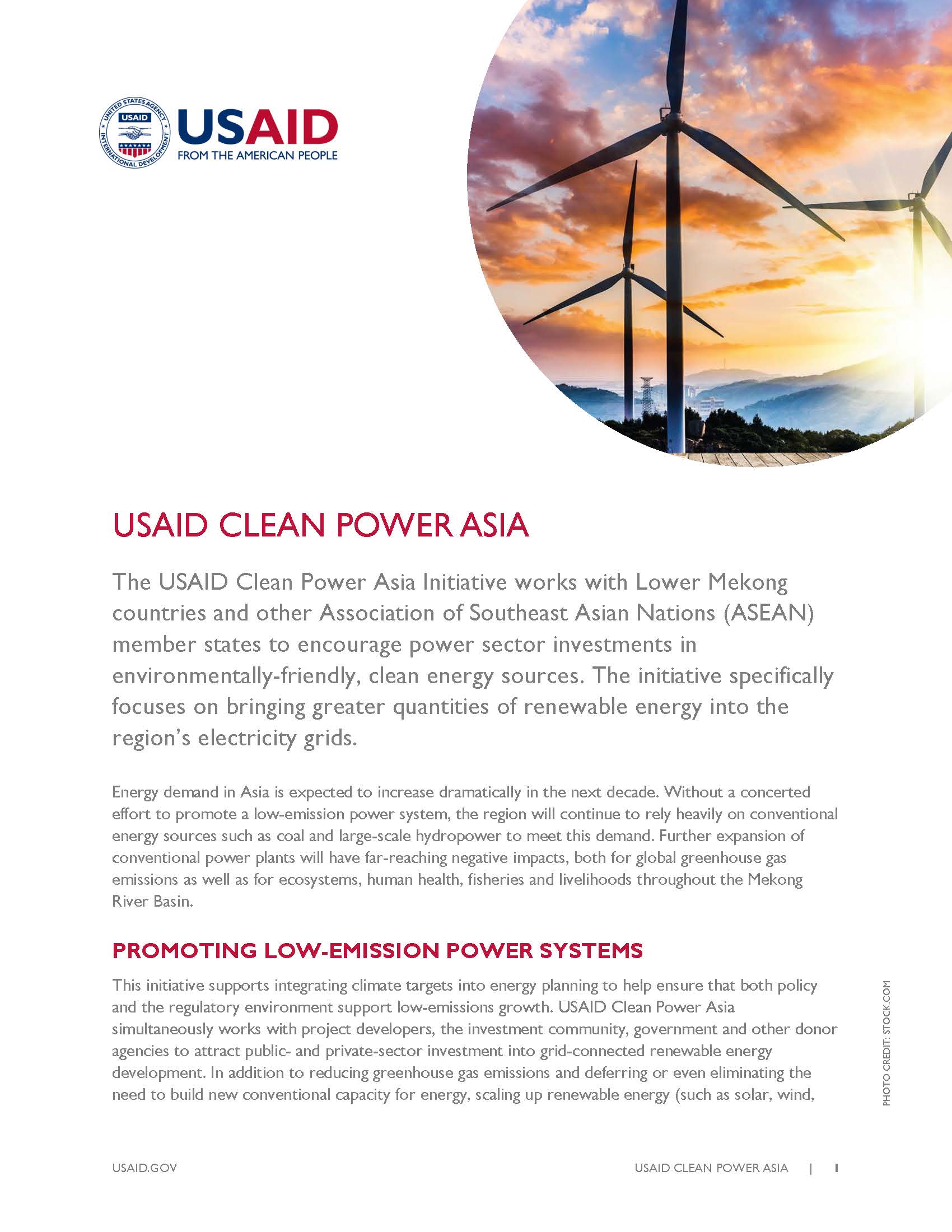USAID Clean Power Asia ![]() (pdf - 261k)
(pdf - 261k)
The USAID Clean Power Asia Initiative works with Lower Mekong countries and other Association of Southeast Asian Nations (ASEAN) member states to encourage power sector investments in environmentally-friendly, clean energy sources. The initiative specifically focuses on bringing greater quantities of renewable energy into the region’s electricity grids.
Energy demand in Asia is expected to increase dramatically in the next decade. Without a concerted effort to promote a low-emission power system, the region will continue to rely heavily on conventional energy sources such as coal and large-scale hydropower to meet this demand. Further expansion of conventional power plants will have far-reaching negative impacts, both for global greenhouse gas emissions as well as for ecosystems, human health, fisheries and livelihoods throughout the Mekong River Basin.
PROMOTING LOW-EMISSION POWER SYSTEMS
This initiative supports integrating climate targets into energy planning to help ensure that both policy and the regulatory environment support low-emissions growth. USAID Clean Power Asia simultaneously works with project developers, the investment community, government and other donor agencies to attract public- and private-sector investment into grid-connected renewable energy development. In addition to reducing greenhouse gas emissions and deferring or even eliminating the need to build new conventional capacity for energy, scaling up renewable energy (such as solar, wind, small-hydro and biomass residues) can deliver significant development benefits. These include providing reliable energy access, improving air quality, reducing health costs, boosting economic growth, mitigating transnational conflict, promoting food security and biodiversity, as well as reducing direct energy costs.
POWER SECTOR PLANNING
A major challenge for implementing renewable energy at scale is to integrate climate targets and renewable energy planning into power sector planning. This initiative will support the establishment and updating of national renewable energy targets and the integration of these targets into power development plans and integrated resource plans for the power sector. USAID Clean Power Asia will also work to rationalize the planning and development of renewable energy by linking it to the transmission planning process. Experience around the world has shown that renewable energy zones can improve access for renewable energy providers and contribute to cost reductions in the provision of grid-connected renewable energy. This initiative will help establish a stakeholder collaborative process for renewable energy zone development in the region.
MOBILIZING PUBLIC AND PRIVATE SECTOR INVESTMENT
Although renewable energy investments offer a range of promising new business opportunities, project developers have faced formidable financial and regulatory challenges. In the Lower Mekong region in particular, renewable energy projects receive less interest than traditional capital investments. At the same time, barriers exist for banks and financial institutions to effectively engage and invest in renewable energy. USAID supports financial institutions, developers and other relevant stakeholders to secure and reduce the cost of finance for renewable energy projects by: helping to develop innovative business models; promoting standardized documentation and evaluation practices and approval processes for financing renewable energy projects; and providing other advisory services.
IMPACT AND RESULTS
USAID Clean Power Asia is expected to mobilize at least $750 million in clean energy investments over the next five years. It will also support installing at least 500 megawatts of grid-tied renewable energy generation and assist to implement laws, policies, strategies, plans or regulations that contribute to reductions of greenhouse gas emissions.
Click here for the pdf file.








Comment
Make a general inquiry or suggest an improvement.